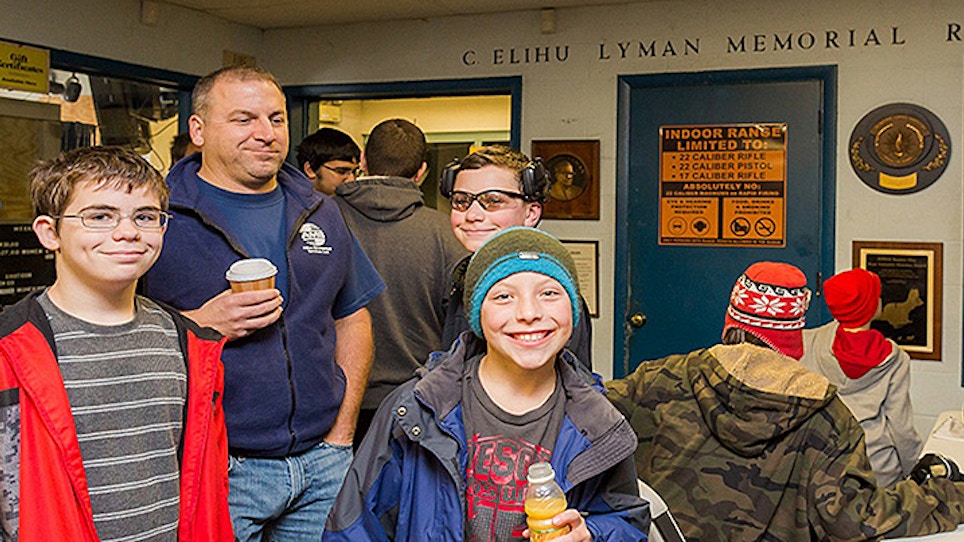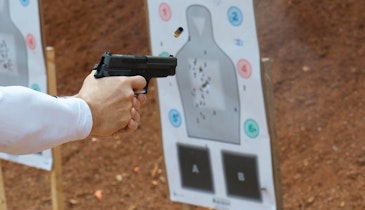Another month-end’s accounting has come and gone, and the numbers confirmed what you’d thought: The sales volume pretty much met the forecasted expectations, and there was even a little bit more to show for it than you’d anticipated. Firearms sales remain steady, even if they’ve come down from the insane levels of a couple of years ago, and the continued interest among your newer customers — accounting for respectable accessory and consumables sales — has helped to prevent those numbers from sagging.
Ho hum…
At this rate, your original plans and hopes from when you opened the store five years ago will take forever.
You need something that will act as a shot in the arm to reinvigorate interest among your existing customers and bring some new faces into your doors, and hosting in-store events could be just the thing.
“Store and range events keep your business going,” says David Lyman at Blue Trail Shooting Range in Wallingford, Connecticut. The facility is one of the largest ranges in New England and has been in business for 70 years.
Clearly they’ve been doing something right during all that time.
Before you start scheduling a weekly blowout, however, it’s prudent to determine what your goals are. To be sure, you’d like a ton of traffic, very brisk sales, and plenty of profit. But it’s necessary to be specific about what exactly you want to get out of any event.
Write It Down
“One of the biggest mistakes that people often make when they try any new marketing tactic is that they’re not quite sure what they want to get out of it,” says leading event accessory maker JC Leisure Connexions. “They’ll hear that a certain strategy can work really well, so they decide to give it a go, but they don’t take the time to set their objectives and really understand what results they want for their business.”
So write it down on paper and get your goals straight.
“Do you want to drive sales at the event? Do you want to get media coverage? Do you want to increase awareness of your brand?” writes JC Leisure. “It could be all of these things, or something else entirely, but make sure that you really understand what you want to achieve.”
In other words, be very detailed about what it is you’d like to accomplish. Is there a particular product you’d like to promote? Are you setting a quota to attract some number of new customers? Do you want to use this as a tool to help with the training of one or more new employees? It’s probably a good idea to discuss your goal or goals in advance with partners or senior staff and come up with a written firm statement on what the goals may be.
Remember also that events can take a variety of forms, with each serving a different goal.
Blue Trail Range, for example, hosts a variety of events ranging from hands-on days (a manufacturer like Smith & Wesson, Kahr Arms, or another will come in and interact directly with customers on that maker’s line of products), to their ongoing Junior Rifle Club for youngsters aged 9 to 19, to a number of “contract” style events like corporate gatherings and birthday parties.
Searches have shown that the type, style and flavor of events vary tremendously and are limited only by a retailer’s imagination. Some types that are fairly widespread include things like ladies nights, shooting competitions (in as many styles or calibers as a range’s facilities may have available), instruction and more.
But some of the more unusual ones include things like “Kids in the Know” (Centennial Gun Club of Centennial, Colorado), Bowling Pin Matches (also Centennial), “Zombie Extermination” (Nardis Gun Club of San Antonio, Texas) and others. Again, determine what it is you’d like to accomplish, and tailor the event accordingly. One of the tried-and-true styles like ladies nights or manufacturer demos may serve you perfectly well, but don’t be afraid of letting your imagination go a little crazy.
Pick A Day
Okay, you have the goals set and event description worked out. The next step is to determine exactly when to hold the event.
Does the event lend itself to a particular season or time of year? Will it be tied to a holiday? Will it be weather dependent? And then, once you’ve determined which month or season, choose the date with care since you don’t want to be competing for local traffic with any large-scale happening that same day that would keep your target market from coming in. Things to watch out for are mainstream sporting events, municipal happenings and the like.
Next comes promotion, and this is an area where many facilities come up short; there are few things as frustrating as going through the effort and expense to put together one hell of a kickass event, only to have just a few folks trickle in.
Be sure to do both in-house and external promotion. Lyman tells us that months in advance of a large event he makes sure to print up fliers and put up posters, so that any foot traffic coming through the store in advance will have an opportunity to learn about it.
Advertising, as always, has its place, and some of the classical media outlets can serve a useful function here. These include radio, television and local newspapers. As time goes by, more and more small independent firearms retailers are finding that radio ads are providing one of the best returns for their ad dollars, and Lyman agrees.
But don’t rely only on mass appeal to bring in people; it’s good to reach out to people individually as well.
“So now that you know what you’re aiming for, it’s time to think about who you’re going to invite,” JC Leisure says. “You might want to ask existing customers, people who have shown an interest in your offerings in the past but have not yet bought from you, any press contacts that you might have who could be interested in running a story, and possibly even fellow business owners in your local area.”
Advisability on inviting local press may, however, be debatable. The primary factor that will determine this is your own knowledge of the local press and its relationship with your facility — and of the greater region’s firearms attitudes. Even if a reporter attends, however, it would undoubtedly be prudent to closely supervise the journalist using somebody who has experience in dealing with the press.
Budgets
If you haven’t already, be sure to set up a workable budget for the event, and stick with it.
There are any number of factors that must be considered, not the least of which is the manpower that will be needed to keep things running properly. Lyman also advises that you make sure that the people you need to have on hand will be available and have committed to that time. If you suddenly find yourself short-handed in the thick of things while the event is in progress, at the very least you’ll be in for a good amount of stress.
Be sure to account for things like catering, advertising budget, promotional materials, security, cost of set-up and break-down and many other details. It might be possible to get some assistance from the industry in the form of sponsorship by one or more of the manufacturers, but Lyman warns us that these sponsorship dollars are less plentiful than they used to be, and in many cases can not be relied upon.
As an aside, Lyman informs us that the hands-on manufacturers events are typically very well attended, but cautions that these might not always be readily available.
“The manufacturers don’t always like doing these,” he tells us. “They find it time-consuming and the reps aren’t always available to do them. And when the market is hot and gun sales are brisk, they don’t have quite as much motivation to invest in these. But during slower sales periods they can be very worthwhile.”
The Spoils Of Victory
It’s a good idea to consider having some sort of sign-in sheet, or even a short questionnaire, for the event. Besides the obvious benefit of being able to track attendance and get some idea of the times that traffic was greatest or thinnest, it’s also a great way to increase your contact list.
Requesting information like name, email, phone number and interests can bolster your customer and marketing database significantly. But be sure to keep it relatively simple so that it won’t take more than a few minutes to fill it out; you don’t want a newcomer to be immediately turned off by having to sit and slog through what might seem like a mound of unexpected paperwork.
Once the event is done, it’s important to review and evaluate it, and this is best done sooner rather than later.
“This is the step that most people forget about,” one events expert warns. “The story isn’t over after your event. Make sure you don’t miss out on the opportunity to review your successes and the areas that could have been improved, and think about what you would do differently next time.”
One important consideration in this evaluation process is relating any of the immediate results to actual benefits to your store. On one hand, you might have seen all of the benefits originally forecast for the event, but on the other hand there will be all of the expenses, difficulties, effort and hours that went into the event’s planning, completion and cleanup.
And of course it’s difficult to assign an objective value to all of the aggravation that you endured along the way.
“Even though events might require lots of expense and hundreds of man-hours, it’s not easy to determine just how cost-effective it is,” Lyman points out. “You have to consider both the immediate and the residual effects. Some of those residual effects might not be apparent for weeks or months, or even years, so it can very difficult to assess the event’s overall value.”
Chances are, in most cases it will be well worth it. In-store events are a proven interest- and profit-generating phenomenon in most industries, and it undoubtedly lends itself particularly well to the shooting sports, where the products and activities have undeniable visual and tactile appeal — most people find the sight and feel of firearms to be downright compelling.
Add these qualities to a social and convivial atmosphere, and you have a winning formula.






